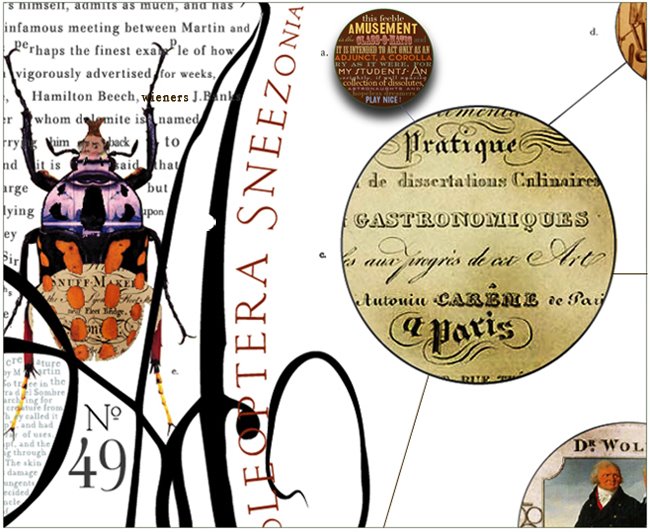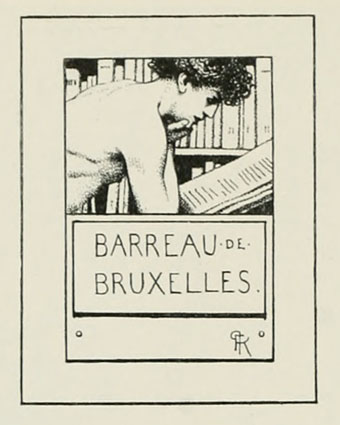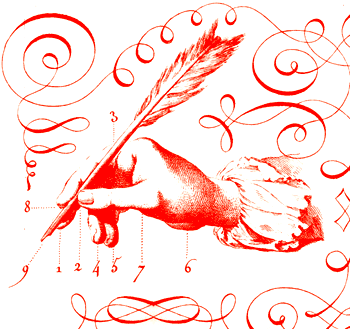Tuesday, September 25, 2012
Absinthe is an original typeface created by english designer Franck Trebillac. A strong personality set in a balance of retro curls and straight lines. Download the font for free here, available in three cuts: regular, italic and flourish.
Sunday, September 23, 2012
a bookplate is, characteristically, a dedication page, and it's usually found - at the very front of a book.
It can serve various functions; to illustrate something about the volumes owner by theme, or it may delineate the particular interests, personality or more likely the pretentions of the designer of the image, or owners of the book.
You know, the Ex Libris (from the library of... etc.) it acts much as a bumper sticker might on a car - aka Go HABS Go !
It can serve various functions; to illustrate something about the volumes owner by theme, or it may delineate the particular interests, personality or more likely the pretentions of the designer of the image, or owners of the book.
You know, the Ex Libris (from the library of... etc.) it acts much as a bumper sticker might on a car - aka Go HABS Go !
The following images are from Modern Book-plates and their Designers, an overview of British, American and European bookplate and book designs published by The Studio magazine in 1898.
These small Studio books are rather beautiful objects, and quite collectable - not least, for the period ads in the opening and closing pages of the books.
A couple of the design styles are familiar from later works, notably Cyril Goldie’s remarkable accumulation of thorns and skulls, (and you guys thought this was a contemporary idea ...) Many others are illustrated in the swirling, tendrilled style of Art Nouveau which The Studio did much to promote in Britain.
Also of interest are a few entries from well-known fine artists who are seldom associated with this kind of graphic/bookplate design. Among these is Belgian Symbolist Fernand Khnopff and the Brit Symbolist/Decadent Aubrey Beardsley.
Sunday, September 16, 2012
 Admittedly, at first glance, most of you will find this post pretty silly.
Admittedly, at first glance, most of you will find this post pretty silly.But, in my defence these quirky objects are - while being faintly ridiculous, secretly marvelous.
Especially, if you look just beneath the surface (excuse the pun). These fishing lures, often called "poppers" are a wonderful fusion of individual styling and some tangible glimpses of real engineering vision, and, just as the classic shark finned Chevy and Ford cars of the American post war, these too, eloquently express the sentiments of their era.
In fact, I'm not really overstating the case, as this little slice of mid-century Americana - is as expository as any Fender telecaster guitar or any of Raymond Loewy's famous designs for Lucky Strike cigarettes or Coca Cola. Objects, naturally reflect their time, in both form and in materials, and some more notable examples are reasonably so - candidates for the time capsule.
If you want to know the secrets of an age, check out their toys.
In fact, I'm not really overstating the case, as this little slice of mid-century Americana - is as expository as any Fender telecaster guitar or any of Raymond Loewy's famous designs for Lucky Strike cigarettes or Coca Cola. Objects, naturally reflect their time, in both form and in materials, and some more notable examples are reasonably so - candidates for the time capsule.
If you want to know the secrets of an age, check out their toys.
And, as surely as the pale pastel mid-century desert architecture of Las Vegas implies, these mad hat fishing lures are quintessentially mid American, and subtly reiterate that most American of virtues, hope.
Hope, in the sense of that near compulsive faith in one's success, however unlikely, because how else could they possibly work ? They sure don't look like fish? The standing joke of course is - that they catch fisherman, not fish.
Beginning as a fashion in late 1880's in England, artificial lures were then hand made by artisans. Exported world wide through the colonies at the turn of the century, along with other cultural artifacts amusements and pretensions, mass production began in earnest around the 1930's, and continued unabated up and until the 1980's in most of America.
By then, these artificial fishing lures were are as ubiquitous as the telephone. Naturally each era, re-defines and re-expresses the aesthetics and technologies their age, none, much more so, than these eccentric little baubles. Enjoy
By then, these artificial fishing lures were are as ubiquitous as the telephone. Naturally each era, re-defines and re-expresses the aesthetics and technologies their age, none, much more so, than these eccentric little baubles. Enjoy


Saturday, September 08, 2012
design two, yes you ! read this
http://www.nytimes.com/2010/07/01/garden/01peter.html?pagewanted=1&_r=1
http://www.nytimes.com/2010/07/01/garden/01peter.html?pagewanted=1&_r=1
Subscribe to:
Posts (Atom)















